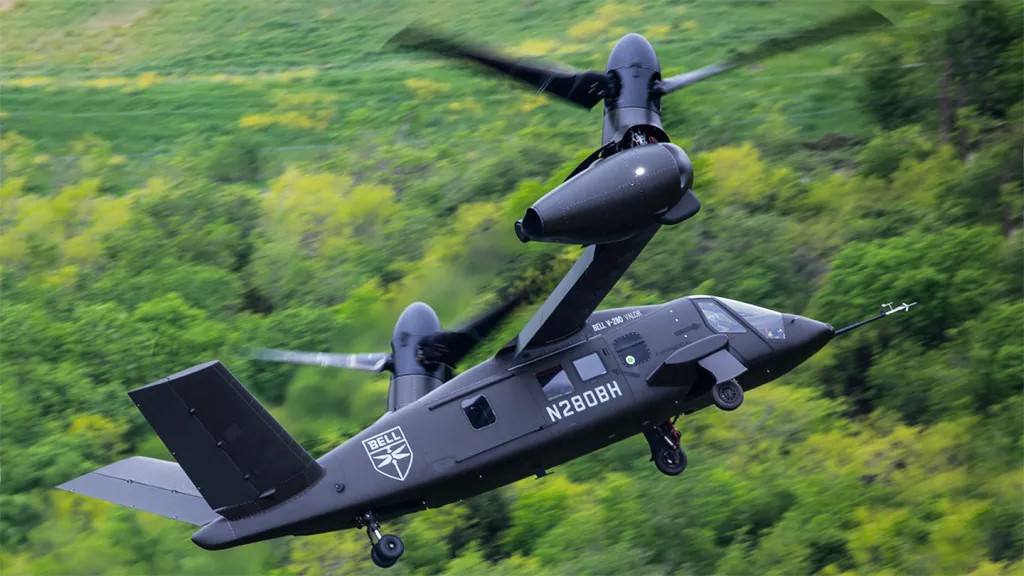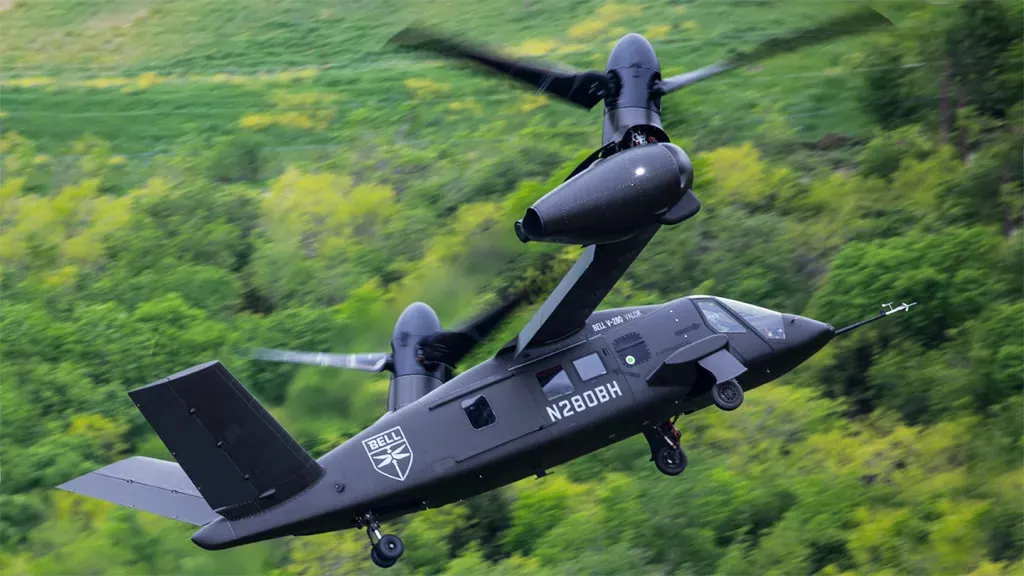The U.S. Army is in the very early stages of formulating a vision for fleets of advanced and highly autonomous drones in a similar vein to the Collaborative Combat Aircraft (CCA) that the U.S. Air Force, U.S. Marine Corps, and U.S. Navy are now developing. The Army’s CCA endeavor may ultimately be linked, at least in some way, with work already being done on so-called “launched effects,” a term generally applied to smaller uncrewed aerial systems designed to be fired from other platforms in the air, as well as on the ground and at sea.
Army aviation officials talked about the current state of the service’s CCA plans during a roundtable on the sidelines of the Association of the U.S. Army’s (AUSA) main annual conference this week, at which TWZ was in attendance. The topic had also come up elsewhere during the three-day event, which ended yesterday. Army CCAs would be primarily expected to operate in close cooperation with the service’s existing crewed helicopters, as well as its future MV-75A tiltrotors.

“So, one, we’re following the other services very closely as they’re looking at this, this [CCA] concept,” Brig. Gen. Phillip C. Baker, the Army’s Aviation Future Capabilities Director, said. at the roundtable. “I think for the Army, especially launched effects, it comes down to a discussion of mass. … A platform, a loyal wingman, a CCA concept, allows you to increase mass while also reducing the amount of aviators you’ve got to have in the air.”
Baker noted that the Army is working in particular with U.S. military commands in the Pacific and European regions as it begins to explore potential CCA requirements, which might lead to an operational capability in the next few years. For the past year or so, the Army has been working to figure out “the capabilities that they need in order to deliver that mass, and really survivability,” he added.

At present, a key aspect of the ongoing discussions within the Army seems to be focused on where the service’s existing work on launch effects ends and where a CCA-like effort might begin.
“Launched effects, if you think about it, is a CCA, right?” Maj. Gen. Clair Gill, commander of the Army Aviation Center of Excellence, also said at the round table. “These are things that we’re going to launch off of aircraft and are going to operate in a collaborative fashion, potentially autonomously, but we’re going to give them instructions, and they’re going to operate based off of guidance, either off of something on the ground or maybe they’re being quarterbacked in the air.”
“Manned-unmanned teaming is the future. We’ve talked about the potential of launched effects off the aircraft, or a potential loyal wingman,” Col. Stephen Smith, head of the Army’s elite 160th Special Operations Aviation Regiment, better known as the Night Stalkers, had also said during a separate panel at this year’s AUSA conference. Smith had talked about increased use of drones as part of larger efforts to help his unit operate more effectively and just survive in higher-threat environments during future high conflicts, which you can read more about here.

The Army is already envisioning at least three categories of launched effects, broken down into short, medium, and long-range types. They could be configured for a variety of missions, including reconnaissance, electronic warfare, communications relays, and as acting as loitering munitions or decoys. The service has long said that it sees these systems, which could also be networked together in highly autonomous swarms, operating forward of friendly forces, extending the reach of their capabilities, while also reducing their vulnerability.

In some broad strokes, the benefits that launched effects and CCA-types drones offer do align, on top of the “affordable mass” they both promise to provide. However, as the Army currently describes them, even the largest launched effects are substantially smaller and less capable than something in the generally accepted CCA, or ‘loyal wingman,’ category. Most, if not all launched effects are also expected to be fully expendable, unlike a CCA. Any Army CCAs would likely carry launched effects themselves, further extending the reach of the latter drones into higher-risk environments, as well as the overall area they can cover quickly. This, in turn, would allow for a crewed-uncrewed team capable of executing a complex and flexible array of tactics.
When asked then to clarify whether a future Army CCA effort would be distinct from the service’s current launched effects efforts, Maj. Gen. Gill said that “it could be, yes.”

“So, last fall, we actually asked industry what they can provide for a Group 4 VTOL/STOL [vertical takeoff and landing/short takeoff and landing] perspective,” Brig. Gen. David Phillips, head of the Army’s Program Executive Office for Aviation (PEO-Aviation). “So we use that as a great set of information on what the state of the art of technology is from a range, speed, payload, and really effects perspective. What can we bring to bear, given modern technology versus some of our older UAS [uncrewed aerial systems].”
The U.S. military groups uncrewed aircraft into five categories. Group 4 covers designs with maximum takeoff weights over 1,320 pounds, but typical operating altitudes of 18,000 feet Mean Sea Level (MSL) or below. As mentioned already, this is far heavier and higher-flying than any of the UASs the Army is currently considering to meet its launched effects needs.
“I think we’re informing Gen. Gill and Gen. Baker’s teams on what industry has told us on what requirement that shapes out to be,” Phillips added. “It might not look like some of the things we’ve seen on the [AUSA show] floor today. But I can tell you, we received a very robust response from industry, and it’s a combination of maybe some of the things you’d seen on the floor, but we’re excited to start thinking about that space.”
Boeing announced plans for a family of new tiltrotor drones, collectively called Collaborative Transformational Rotorcraft, or CxRs, at this year’s AUSA conference, which you can read more about here. The company said the designs will fall into the Group 4 and Group 5 categories. Per the U.S. military’s definitions, the only difference between Group 4 and Group 5 is that the nominal operating altitude for the latter extends above 18,000 feet MSL.

Last week, Sikorsky, now a subsidiary of Lockheed Martin, announced its own plans to expand existing work on a VTOL drone with a so-called rotor-blown wing configuration into a full family of designs dubbed Nomad, which is set to include a Group 4 type. You can learn more about Nomad, which was also showcased at AUSA, here.

Nearly a decade ago now, Bell also announced it was working on a design for a Group 5 tiltrotor drone called the V-247 Vigilant, aimed originally at a Marine Corps requirement. The V-247, or a scaled-down derivative, could be another starting place for a future Army CCA. Bell has notably shown renderings, like the one below, depicting V-247s operating together with versions of its crewed V-280 Valor tiltrotor design, which the Army’s MV-75A is based on.

Brig. Gen. Baker said that experimentation with CCA concepts, to varying degrees, is already underway, and that more is planned for the near future. He also pointed out that the Army is presented with unique questions to answer compared to the Air Force, Marines, and Navy, given that those services primarily expect CCA-type drones to operate collaboratively with higher and faster-flying fixed-wing tactical jets. The Army, in contrast, as noted, sees any such uncrewed aircraft partnered with its existing helicopters, as well as its future MV-75A tiltrotors, with much lower and slower operational flight profiles. It is worth noting here that the other services still have many questions to answer when it comes to their future CCA fleets, including how they will be deployed, launched, recovered, supported, and otherwise operated, let alone employed tactically.
The video below from Collins Aerospace offers a relevant depiction of what the Air Force, Marine Corps, and Navy expect future air combat operations involving their CCAs to look like.

“So, our experimentation really lies in two areas. One, our modeling that we do constantly. We do that with the feedback that [Brig.] Gen. Phillips talked about from industry. How do you put that [notional system] into a threat environment, and how does that play out, and really render the specifications that we’re looking at,” Baker explained. “The second piece is, we do an annual experimentation out west. That will be the second quarter this year. And, so, we are looking at vendors, potentially, to come out and partner with us to build off the study that [Brig.] Gen. Phillips did, of what’s truly [the] capability out there.”
“When you look at a CCA role for – really linked to rotary wing, that is a different dynamic than you have at 20-to-30,000 feet,” he added. “So it’s a whole set of different behaviors, a whole set of different capability you need to marry that up with an aircraft that’s flying at 100 feet, at 150-plus knots, at night. So that is what we’re really looking at, is what is the state of technology right now to develop a requirement that we can deliver.”
Altogether, the Army still clearly has many questions of its own to answer as it begins to explore concepts for future CCA-drones in earnest, including how such a program would fit in with work it is already doing in the uncrewed aerial systems space.
Contact the author: [email protected]
